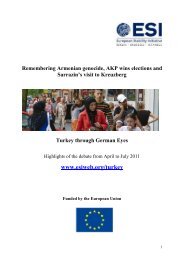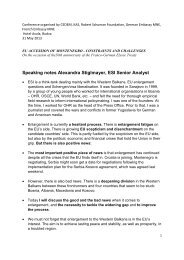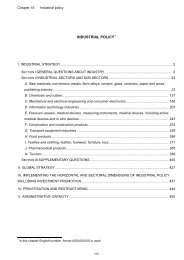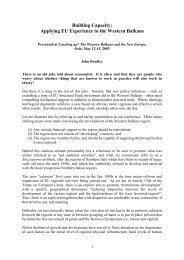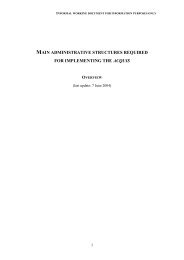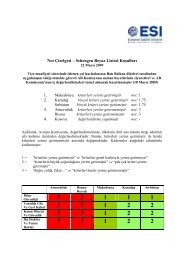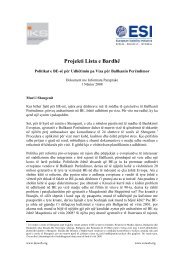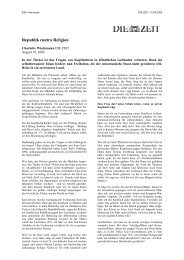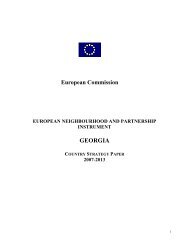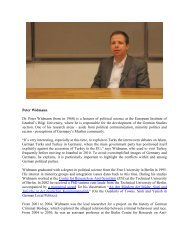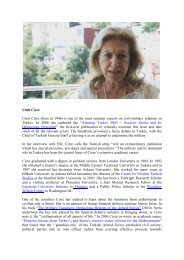MURDER IN ANATOLIA - European Stability Initiative - ESI
MURDER IN ANATOLIA - European Stability Initiative - ESI
MURDER IN ANATOLIA - European Stability Initiative - ESI
You also want an ePaper? Increase the reach of your titles
YUMPU automatically turns print PDFs into web optimized ePapers that Google loves.
1. <strong>IN</strong>TRODUCTION<br />
– 1 –<br />
In April 2007 a gruesome triple murder took place in the Central Anatolian city of Malatya.<br />
The victims, tortured, stabbed and strangled, were two Turks and one German. All three were<br />
Protestant Christian missionaries who had recently moved to Malatya. Five young men,<br />
armed with knives and covered in blood, were found at the scene of the crime only moments<br />
after it happened.<br />
What made the Malatya killings different from an ordinary murder case was the suspicion,<br />
present from the outset, that this was not an isolated attack by a group of nationalist<br />
youngsters. As the investigation unfolded, serious questions began to emerge, which have not<br />
yet been answered. Were anti-government elements of the Turkish state – or, more<br />
specifically, secret networks within the Turkish gendarmerie and ultranationalists linked to<br />
them – involved? Was the murder of missionaries in Malatya an operation by Turkey‟s socalled<br />
“deep state” to destabilise an elected government by targeting Christian “enemies” of<br />
the Turkish nation? 2<br />
This has certainly been the impression of the team of lawyers, a who-is-who of Turkey‟s<br />
most prominent human rights defenders, who have been representing the families of the<br />
victims in the Malatya trial that began in November 2007. From the very beginning these<br />
lawyers have drawn attention to the anti-Christian and anti-missionary campaigns in Turkey<br />
that were supported by a number of ultranationalist associations and writers and which had<br />
gained intensity in the period leading up to the Malatya murder. They also underlined that the<br />
murdered Christians had in fact been under permanent close observation by the gendarmerie<br />
and that the main murder suspect, Emre Gunaydin, had close contacts with the police. They<br />
pointed out that the gendarmerie was monitoring missionary activity in close cooperation<br />
with academics at Malatya University, whose rector was an outspoken ultranationalist,<br />
regularly meeting with leaders of the Turkish military.<br />
As the Malatya trial unfolded, many more links have emerged between the Malatya murders<br />
and ultra-nationalists elsewhere in Turkey who have since been arrested for plotting to<br />
overthrow the government, for which, prosecutors have argued, they had formed a terrorist<br />
network called Ergenekon. 3 Witnesses in Malatya explicitly linked the murders of the<br />
missionaries to an infamous institution much discussed in Turkey in the 1990s as being<br />
responsible for a series of mysterious assassinations, the secret Gendarmerie Intelligence and<br />
Counter-terrorism Department (Jandarma Istihbarat ve Terorle Mucadele, or JITEM)<br />
together with one of its alleged founders, a Turkish ultranationalist and retired gendarmerie<br />
general, Veli Kucuk. Kucuk himself played a leading role in anti-Christian campaigns in<br />
Istanbul which preceded the assassination of Turkish Armenian journalist Hrant Dink. 4 Both<br />
in Malatya and in Istanbul the local branches of the ultranationalist Grey Wolf youth<br />
2<br />
For background on Turkey‟s power struggles in 2007-2008 see also: <strong>ESI</strong> Briefing: Turkey‟s dark side. Party<br />
closures, conspiracies and the future of democracy, April 2008.<br />
3<br />
For background on Ergenekon see also: <strong>ESI</strong> Briefing: Turkey‟s dark side. Party closures, conspiracies and the<br />
future of democracy, April 2008.<br />
4<br />
In 2006 Veli Kucuk was part of a group of aggressive ultranationalists holding up a banner outside a court<br />
room in which Hrant Dink was tried on the charged of insulting Turkishness, which accused Dink of being “the<br />
son of a missionary.” See also: Fethiye Cetin and Deniz Tuna, Third Year Report on Hrant Dink‟s Murder, p. 4.<br />
To understand the background to the Hrant Dink case this is essential reading, as is the most recent Fourth Year<br />
Report on Hrant Dink‟s Murder. Read also this 2009 briefing on the trial by the former member of the <strong>European</strong><br />
Parliament, Joost Lagendijk: Hrant Dink – A Victim of Intolerance and the Quest for Justice, July 2009. For<br />
more on Hrant Dink go here: http://www.esiweb.org/index.php?lang=en&id=311&film_ID=10&slide_ID=24.<br />
~ www.esiweb.org ~




